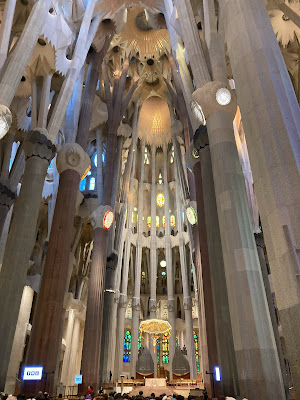A little background on Barcelona. It is in the region of Catalonia, which has its own history, traditions and language. Catalan is spoken by over 12 million people in Catalonia, southern France, and Sardinia. It sprang up in the 1200s and was suppressed after the Spanish War of Succession around 1700. Barcelona thrived during the 1800s Industrial Revolution and experienced the 'Renaixença,' a rebirth of pride in Catalonian culture and language. After the Spanish Civil War from 1936-39, Franco banned Catalan. He died in 1975 and Catalan was once again recognized as an official language. We observed that signs in Barcelona were often first in Catalan, second in English and third in Spanish.
Barcelona is a thriving metropolis of almost 2 million people. The region has about 5 million, making it the fifth largest metropolis in Europe (after Paris, the Ruhr, Milan and Madrid). https://en.wikipedia.org/wiki/Barcelona
Catalan is the language of the region of Catalonia and Barcelona. It is as closely related to Italian and the languages of southern France as to Spanish, and maybe more so. Barcelona was the capital of the Visigoths after the fall of Rome and there is the suggestion that 'Catalan' derived from 'Goth Land.'
https://en.wikipedia.org/wiki/Catalan_language
https://en.wikipedia.org/wiki/Visigoths
You will see photos of Modernista buildings that now define Barcelona. 'Modernisme' is the colorful and flamboyant style that emerged there around the time of the Universal Exhibition in 1888 and continued until about 1930, corresponding to the Arts and Crafts and Art Nouveau and Jugendstil movements in the rest of Europe. It shared with Arts and Crafts a focus on traditional styles and craftsmanship and with Art Nouveau, a preoccupation with sinuous lines, organic form and ornament and a rebellion against rigid designs and colorless stone and plaster. https://en.wikipedia.org/wiki/Modernisme
Modernisme had a nationalistic Catalan flavor, embodied by its greatest practitioner Antoni Gaudi. 1852-1926. https://en.wikipedia.org/wiki/Antoni_Gaud%C3%AD



















































